In a solar system, a battery bank has one important job, and that is to offset 100% of your energy usage. So naturally, when sizing a battery bank for your solar system, your energy usage, among other things, should be taken into consideration.
If sized improperly, the battery bank would frequently fail to meet your energy requirements and could have a shorter lifespan than you anticipated.
In this article, I will provide a very thorough, step-by-step guide on how to calculate battery capacity for your solar system, which will include the variables to consider, a few electricity basics that you need to be aware of, and a couple of formulas that you’ll need to use.
Let’s get to it.
How to calculate battery capacity for solar system?
There are 3 main variables that determine the capacity of the battery bank that you need for your solar system. These 3 variables are:
- Your Daily Energy Consumption: This is the amount of energy in Watt-hours (Wh) or kiloWatt-hours (kWh) that you expect your appliances to use on a daily basis. The more energy your appliances use, the more battery capacity you’re going to need.
- The Depth Of Discharge (or DOD for short) of your battery bank: This represents the percentage of your battery bank’s capacity that you can actually use, and will mainly depend on the type or the chemistry of the batteries you’ll be using and how long you want these batteries to last. For example, an 80% DOD means that you can only use up to 80% of your battery bank’s rated capacity, or in other words, discharge it to 20% of its rated capacity.
- Days of autonomy: This represents the number of days in which you want to be able to rely solely on your battery bank for energy. The days of autonomy will depend on how many days in a row you anticipate your solar panels to produce little to no power due to cloudy weather and low solar irradiance, and on whether or not you plan on using a generator.
Once these variables are determined and accounted for, you’ll be able to calculate the capacity of your battery bank using the following formula:
Battery Bank’s Energy Capacity rating (Wh or kWh) = (Daily Energy Consumption (Wh or kWh) x Days Of Autonomy) ÷ (Depth Of Discharge (%) x 0.85)
Please note that the 0.85 factor in the formula represents the efficiency of the system, which includes things like roundtrip efficiency, DC-to-AC conversion efficiency, and wiring losses.
Once the Energy Capacity rating of the battery bank is calculated, you can divide it by the Energy Capacity rating of the batteries you’ll be using to determine the required number of batteries:
Number of batteries = Battery Bank’s Energy Capacity rating (Wh or kWh) ÷ Energy Capacity of a single battery (Wh or kWh)
Below you’ll find an example of how to use these formulas, but first, let me further discuss these variables and how you can determine them.
1- How to determine your Daily Energy Consumption:
Your daily energy consumption is measured in Watt-hours (Wh) or kiloWatt-hours (kWh), with 1 kWh being equal to 1000 Wh. Watt-hours and kiloWatt-hours, which represent Electrical Energy, should not be confused with Watts (W) and kiloWatts (kW), which represent Electrical Power.
While Watt-hours and kiloWatt-hours measure the amount of energy consumed or generated, or in general, transferred, Watts and kiloWatts measure the rate at which energy is being transferred, also known as Power.
A good analogy to remember the difference between these two units of measurement is to imagine a bucket of water being filled or emptied. The bucket is the battery, Watt-hours represents the amount of water in, added to, or taken from the bucket, and Watts represents the rate at which the water is being poured into the bucket, or taken from it.
The relationship between Energy and Power is represented via the following formula:
Energy (Wh or kWh) = Power (W or kW) x Time (hours)
For example, let’s say we have a light bulb, that uses 50 Watts of power. And let’s say that we leave this light bulb ON for 6 hours. The amount of energy that our light bulb consumed during these 6 hours can be calculated as such:
Energy (Wh) = Power (W) x Time (hours)
Energy (Wh) = 50 Watts x 6 hours
Energy (Wh) = 300 Watt-hours
Energy (kWh) = 0.3 kiloWatt-hours
Now that we’ve covered the basics, let’s discuss your daily energy consumption.
Generally, there are 2 ways to estimate your daily energy consumption:
- If possible, by using the energy consumption provided in your utility bill.
- Or by estimating the daily energy use of each of your appliances.
Let’s look at each method individually and see which one works for you.
1- Using the utility bill:
This is the easiest way to determine your daily energy consumption, but will only be possible if you have a utility provided to begin with.
If this is the case for you, all you have to do is find the periodical kWh usage specified in your utility bill and divide the kWh usage by the number of days in that period.
For example, in the image below, you can see that this utility provider specifies the energy consumption of each month in kWh (kiloWatt-hours):
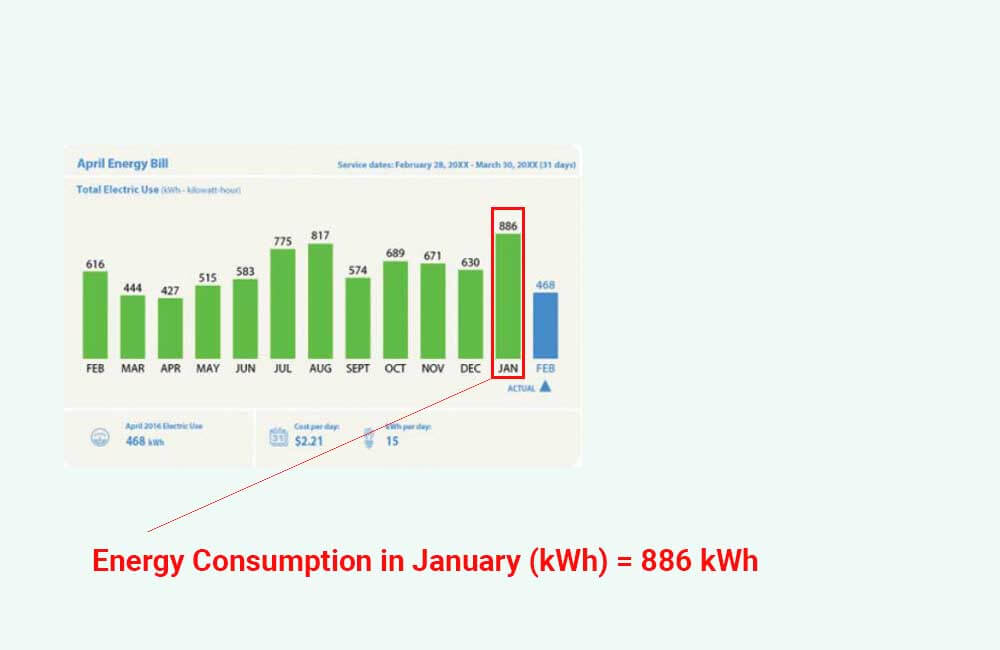
A good idea would be to find the month in which you consume the most amount of electricity and size your battery bank based on the average daily energy consumption in that month. This way, your battery bank will be large enough to supply the energy you need even at maximum usage.
For example, in the bar chart above, you can see that this particular homeowner uses the most amount of energy during the month of January. If we divide that amount of energy by 31 (the number of days in January), we can determine the average daily energy consumption in January:
Average Daily Energy Consumption in January (kWh) = Energy Consumption in January (kWh) ÷ 31
Average Daily Energy Consumption in January (kWh) = 886 kWh ÷ 31
Average Daily Energy Consumption in January (kWh) = 28.6 kWh
Average Daily Energy Consumption in January (Wh) = 28600 Wh
If there is no utility bill to get this info from, you’ll need to use the 2nd method, which requires a bit more work but is just as good.
2- Listing your appliances and their daily energy consumption:
As explained above, Electrical Energy is the product of Electrical Power and Time:
Energy (Wh or kWh) = Power (W or kW) x Time (hours)
Therefore, if you can:
- List all of the appliances that you use during the typical day.
- Determine the Power rating (in Watts) of each appliance.
- Specify the daily use (amount of time) of each appliance.
- Calculate the daily energy consumption of each appliance
You can sum everything up to calculate your daily energy consumption.
You can do this by using our Energy consumption calculator, but in general, it should look something like this:
| Appliance | Power Rating (Watts) | Daily Usage Time (Hours) | Daily Energy Consumption (Watt-hours) |
| Appliance 1 | 40 Watts | 3 hours | 120 Wh |
| Appliance 2 | 40 Watts | 4 hours | 160 Wh |
| Appliance 3 | 60 Watts | 5 hours | 300 wh |
| Appliance 4 | 60 Watts | 3 hours | 180 Wh |
| Appliance 5 | 65 Watts | 6 hours | 390 Wh |
| Appliance 6 | 150 Watts | 8 hours | 1200 Wh |
| Appliance 7 | 500 Watts | 6 hours | 3000 Wh |
| Total Daily Energy Consumption (Watt-hours) | 5350 Watt-hours/day (5.35 kWh/day) | ||
Listing your appliances and their daily usage time is easy enough, but how do you determine the power rating of each appliance?
Typically, appliances come with documentation, or a specification label stuck to the side, back, or bottom of the appliance, in which you’ll find the power rating of the appliance in Watts.
For example, here’s an image of the specification label on the back of a 32″ LCD TV:
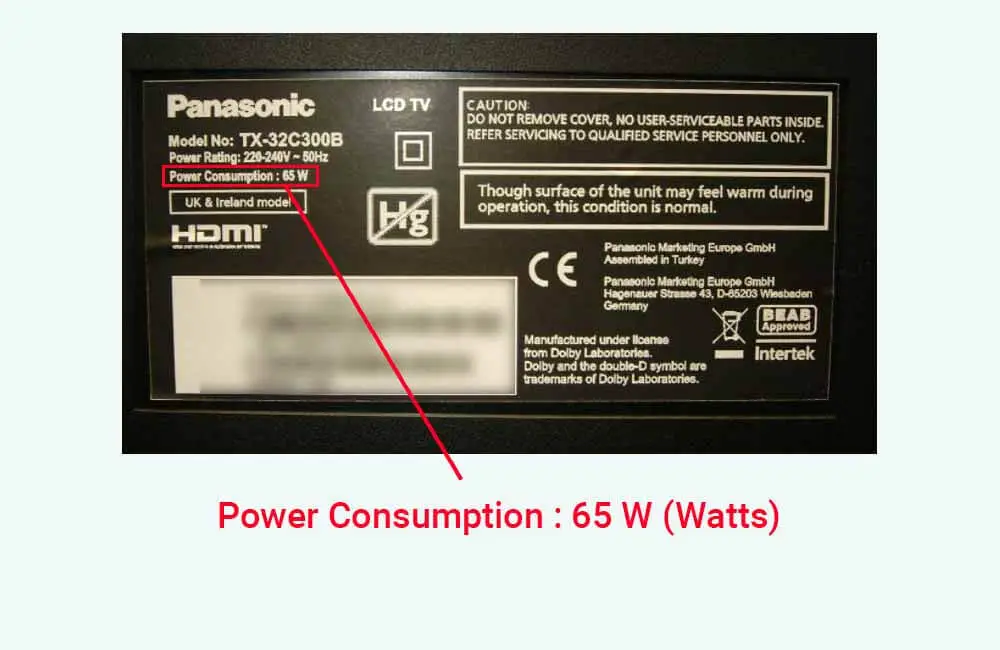
You can see that the manufacturer clearly specifies a power usage of 65 Watts.
If, for example, this TV runs for 6 hours a day, its daily energy consumption is calculated as such:
Daily Energy Consumption (Wh) = Power Usage (Watts) x Time (hours)
Daily Energy Consumption (Wh) = 65 Watts x 6 hours
Daily Energy Consumption (Wh) = 390 Watt-hours
Related: How many watts does a TV use?
Though sometimes, the manufacturer does not provide the Power rating of the appliance, and instead, specifies the Voltage (Volts or V) and Current (Amps or A) usage of the appliance.
In such a case, the Voltage and Current ratings of the appliance can be used to determine the Power usage.
For example, the following image is from a specification label of a refrigerator:
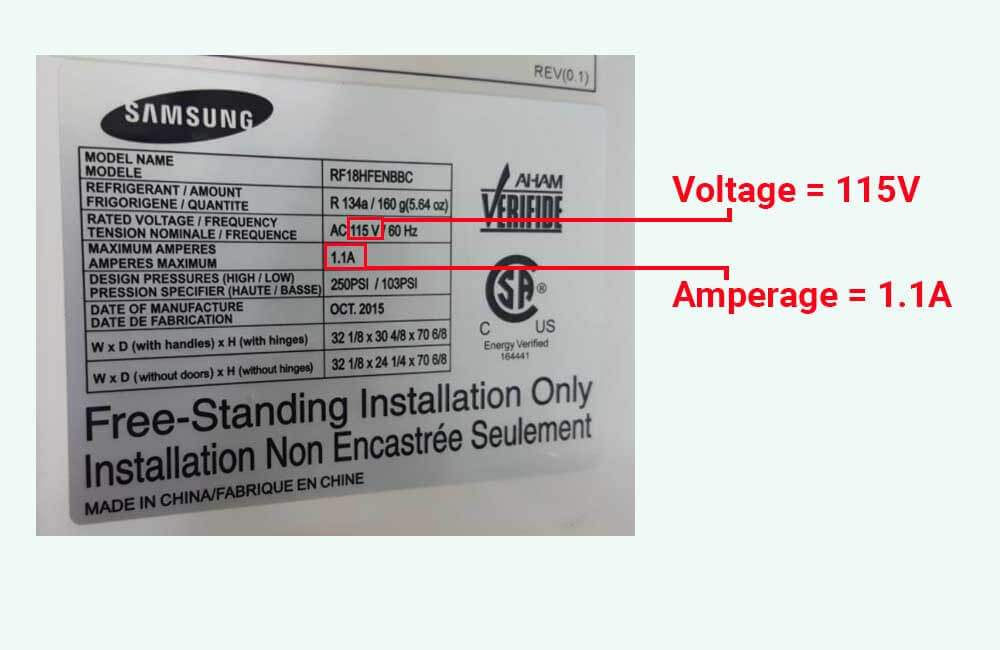
If multiply the Volts and Amps together, we can determine the power usage of this refrigerator:
Power Usage (Watts) = Voltage (Volts) x Current (Amps)
Power Usage (Watts) = 115 Volts x 1.1 Amps
Power Usage (Watts) = 126.5 Watts
However, it is important to note that even when plugged in, some appliances that have a duty cycle, such as refrigerators and air conditioners, do not constantly run or use their rated power 100% of the time.
This is because instead of running at maximum power all the time, like a light bulb or a TV does, these appliances will typically turn on and off in a way that maintains the temperature.
For example, refrigerators are left on 24 hours a day; however, if we multiply the power usage of a refrigerator by 24 hours, we’ll end up overestimating the daily energy usage of the refrigerator.
This is because, during those 24 hours, the compressor in the refrigerator only really runs for 6 to 12 hours (or for 15 to 30 minutes per hour) depending on how high the outdoor temperature is.
Also depending on the outdoor temperature, an air conditioner would run for 30 to 50 minutes per hour that it’s left on.
Related: How much energy does an air conditioner use?
So, with these appliances, multiplying their power usage by their daily use will not result in accurate energy consumption estimates.
How do you determine their energy consumption then?
Well, you have 2 options:
Option 1: Using the Estimated Annual Energy Consumption of the device
A good way to estimate the daily energy consumption of a fridge or AC would be to divide their annual energy consumption estimate by 365. This annual energy consumption estimate is typically found on the EnergyGuide label that comes with the appliance.
For example, here’s an EnergyGuide label that came with a mini-fridge:
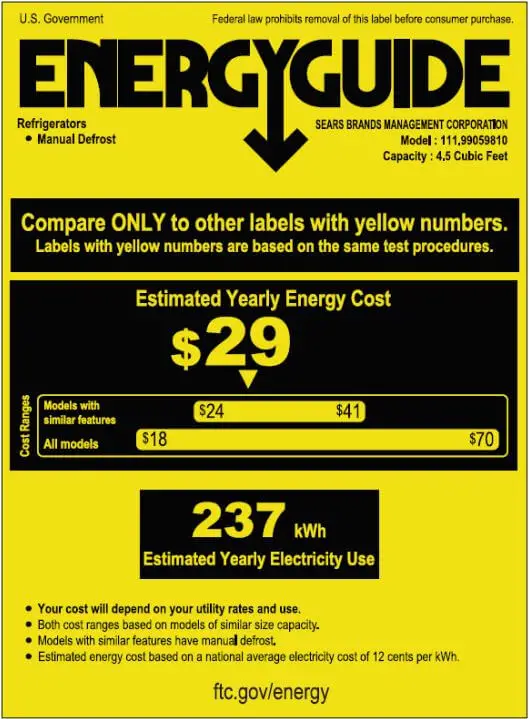
The manufacturer estimates that this mini-fridge uses about 237 kWh of energy per year. If we divide that by 365, we can estimate its daily energy usage:
Daily Energy Consumption (kWh) = Annual Energy Consumption (kWh) ÷ 365
Daily Energy Consumption (kWh) = 237 kWh ÷ 365
Daily Energy Consumption (kWh) = 0.65 kWh
Daily Energy Consumption (Wh) = 650 Wh
However, this is the yearly average. A refrigerator will consume more energy in the summer and less in the winter.
As a rule of thumb, if you multiply the yearly average daily energy usage of the fridge by a factor of 1.5, you’ll get a rough estimate of its daily energy usage in the summer.
Daily Energy Consumption (Wh) = Yearly Average (Wh) x 1.5
Daily Energy Consumption (Wh) = 650 Wh x 1.5
Daily Energy Consumption (Wh) = 975 Wh
If you don’t like rough estimates, then you should go with the 2nd option.
Option 2: Using an electricity metering device
Devices such as the Kill-A-Watt meter allow you to measure the Voltage, Current, Power, and most importantly in our case, the Energy Consumption of the appliance.
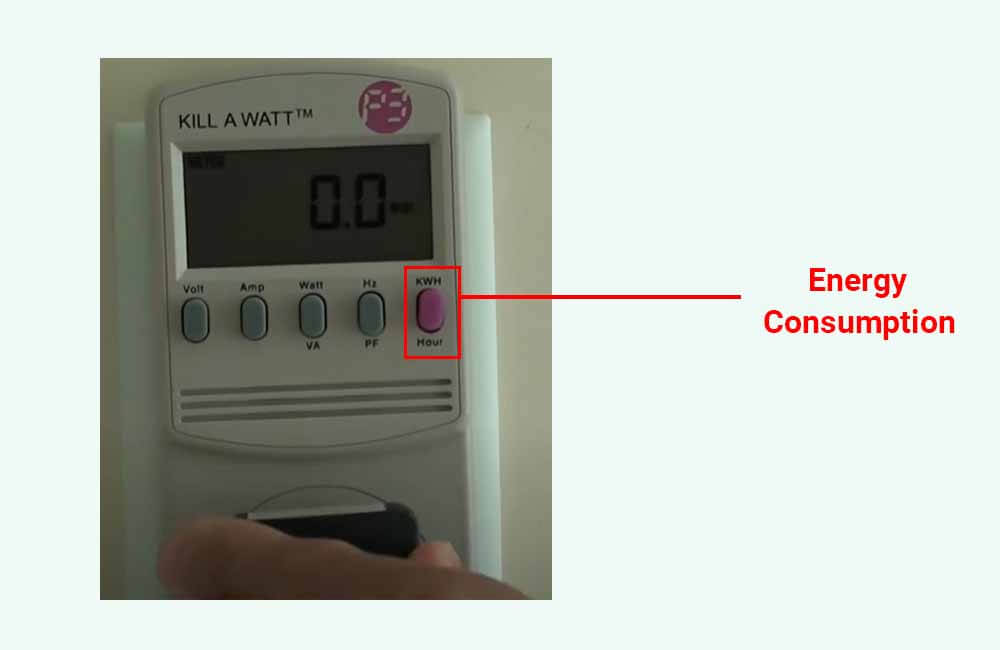
All you have to do is plug the metering device into the outlet, and plug your appliance into the meter, and it will measure the energy usage of the appliance during a certain period.
Now that we’ve covered daily energy consumption, the next variable to discuss is the Depth Of Discharge (DOD) of the batteries you’ll be using.
2- Depth Of Discharge (DOD)
Batteries are rated in:
- Volts (V): This rating represents the nominal voltage across the terminals of the battery (6V/12V/24V/48V).
- Amp-hours (Ah): This rating represents the Charge Capacity of the battery (50Ah/100Ah/200Ah).
- Watt-hours or kiloWatt-hours (Wh or kWh): This rating represents the Energy Capacity of the battery, and is the most important rating.
The relationship between these 3 ratings is:
Energy Capacity (Wh or kWh) = Voltage (V) x Charge Capacity (Ah)
For example, a battery that is rated at 12 Volts and 100 Amp-hours, could be said to have an Energy Capacity of 1200 Watt-hours or 1.2 kiloWatt-hours.
Related: How many Watts is a 100Ah battery?
So, theoretically, a fully charged 12V-100Ah battery can supply 1200Wh (1.2kWh) of energy before it has to be disconnected and recharged. However, in reality, it is not recommended to use all of the 1200 Watt-hours that a 12V-100Ah battery can store.
This is due to the fact that there is a clear correlation between:
- How deep you usually discharge a battery.
- And the lifespan of the battery.
The deeper you usually discharge a battery, the shorter the lifespan of the battery is going to be.
This brings us to the Depth Of Discharge or DOD.
The Depth Of Discharge (DOD) of a battery represents the recommended percentage of a battery’s capacity that can actually be used. For example, if a battery is rated at 1200 Watt-hours, and has a recommended DOD of 50%, only 600 Watt-hours of the battery’s energy capacity is actually usable.
The DOD of a battery will mainly depend on its chemistry and what it’s designed for. Discharging a battery deeper than it is recommended will reduce the capacity of the battery and its overall performance.
In general, if you’re going to use Lithium batteries for your solar system, you’ll be able to use 80 to 100% of your battery bank’s rated capacity (80-100% DOD). If you’re going to use Lead-Acid batteries, you’ll only be able to use 50% of your battery bank’s rated capacity (50% DOD).
Make sure to determine the recommended DOD of the batteries you’ll be using to properly calculate the capacity of your battery bank.
3- Days of Autonomy:
As mentioned above, days of autonomy refers to the number of days that you want to be able to run your appliances without any additional energy input from your solar panels. Typically, this could be 3 to 5 days.
However, more days of autonomy means a bigger battery bank. Since batteries are the most expensive component of a solar system, relying completely on your batteries for backup would significantly increase the total cost of your system.
If you go for 5 days of autonomy, for example, and find that the size of the battery bank is too big for your budget, you can reduce the days of autonomy and use a backup generator to charge your battery bank when solar output is minimal.
In any case, once you’ve determined your daily energy consumption, the recommended DOD of the batteries you’ll be using, and decided on a number for the days of autonomy, you’ll able to calculate the battery bank’s storage capacity using this formula:
Battery Bank’s Energy Capacity rating (Wh or kWh) = (Daily Energy Consumption (Wh or kWh) x Days Of Autonomy) ÷ (Depth Of Discharge (%) x 0.85)
Let’s look at a quick example.
Example:
In this example, I’ll make the following assumptions:
- My Daily Energy Consumption is – at most – 6000 Watt-hours (Wh) or 6 kiloWatt-hours (kWh) per day.
- The batteries used in my battery bank are going to be these EG4 51.2V-100Ah LiFePO4 (Lithium-Iron-Phosphate) batteries, which the manufacturer claims will last at least 7000 charge/discharge cycles at a DOD of 80%.
- I want my battery bank to be able to supply 3 days’ worth of energy consumption in case it needs to. So, that’s 3 Days of Autonomy.
With these details in mind, I can calculate the Energy Capacity of the battery bank that I need:
Battery Bank’s Energy Capacity rating (Wh or kWh) = (Daily Energy Consumption (Wh or kWh) x Days Of Autonomy) ÷ (Depth Of Discharge (%) x 0.85)
Battery Bank’s Energy Capacity rating (Wh) = (6000 Wh x 3) ÷ (80% x 0.85)
Battery Bank’s Energy Capacity rating (Wh) = (6000 Wh x 3) ÷ (0.8 x 0.85)
Battery Bank’s Energy Capacity rating (Wh) = (18000 Wh) ÷ (0.68)
Battery Bank’s Energy Capacity rating (Wh) = 26470 Wh
So, to be able to supply up to 6kWh of energy per day for 3 days, at a depth of discharge of 80%, my battery bank has to be rated at 26470 Watt-hours or more.
Since the batteries I’ll be using are rated at 51.2V-100Ah, each of these batteries has an Energy Capacity of 5120 Watt-hours. With this in mind, I can calculate the number of batteries I’ll need in my battery bank:
Number of batteries = Battery Bank’s Energy Capacity rating (Wh or kWh) ÷ Energy Capacity of a single battery (Wh or kWh)
Number of batteries = 26470 Wh ÷ 5120 Wh
Number of batteries = 5.17
This means that I would need 6 of these batteries in my battery bank. This would be too expensive for my budget.
Instead, I could reduce the days of autonomy to 1, and get a generator that will charge my battery bank when needed.
By doing this, I would only need 2 51.2V-100Ah batteries + a generator and battery charger, instead of 6 batteries, which would decrease the total cost by – at least – half.



Hello,
this is very useful information. but sizing of battery bank is looks very difficult.
if i have 4000VA of connected load for 24 hours, could you please guide me for 12 hours autonomy.
batteries are12V,200Ah capacity.
Hey there Jagdish,
If I understand your question, you have a 4000 VA (4kW) load that’s continuously running. If so, each hour of runtime requires 4kWh of energy (4kW x 1 hour), so 12 hours of runtime require 48 kWh of energy.
You can calculate the required storage capacity as such:
Battery Bank’s Energy Capacity rating (kWh) = (48 kWh) ÷ (Depth Of Discharge (%) x 0.85)
Since you’re going to use 12V 200Ah batteries, each of these will be rated at 2.4 kWh of energy storage capacity. To calculate the number of batteries that you need, use this formula:
Number of batteries = Battery Bank’s Energy Capacity rating (kWh) ÷ 2.4 kWh
Hope this helps.
Number of batterie